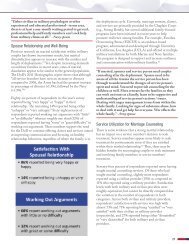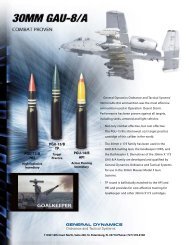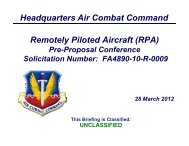F-35 Joint Strike Fighter (JSF) - WordPress.com
F-35 Joint Strike Fighter (JSF) - WordPress.com
F-35 Joint Strike Fighter (JSF) - WordPress.com
Create successful ePaper yourself
Turn your PDF publications into a flip-book with our unique Google optimized e-Paper software.
DOD PROGRAMS<br />
specifications in January 2015. This small margin allows<br />
for only 0.42 percent weight growth per year for the<br />
F-<strong>35</strong>A. The program will need to continue rigorous weight<br />
management through the end of SDD to avoid performance<br />
degradation and operational impacts.<br />
• The program announced an intention to change<br />
performance specifications for the F-<strong>35</strong>A, reducing turn<br />
performance from 5.3 to 4.6 sustained g’s and extending<br />
the time for acceleration from 0.8 Mach to 1.2 Mach by<br />
8 seconds. These changes were due to the results of air<br />
vehicle performance and flying qualities evaluations.<br />
• Discoveries included:<br />
--<br />
Delayed disconnects during air refueling required the<br />
program to implement restrictions on the F-<strong>35</strong>A fleet<br />
and conduct additional testing of the air refueling<br />
capability. The program added instrumentation to<br />
isolate root causes.<br />
--<br />
Horizontal tail surfaces are experiencing higher<br />
than expected temperatures during sustained<br />
high‐speed / high‐altitude flight, resulting in<br />
delamination and scorching of the surface coatings<br />
and structure. All variants were restricted from<br />
operations outside of a reduced envelope until the<br />
test team added instrumentation to the tailbooms to<br />
monitor temperatures on the tail surfaces. The program<br />
scheduled modification of one flight sciences aircraft of<br />
each variant with new skin coatings on the horizontal<br />
tail to permit flight testing in the currently restricted part<br />
of the high‐speed / high‐altitude flight envelope. The<br />
test team is adding more flight test instrumentation to<br />
help quantify the impacts of the tail heating to support<br />
necessary design changes. The program scheduled<br />
modifications on one aircraft (AF-2) to be <strong>com</strong>pleted in<br />
early 2013 to allow flight testing of the new skin design<br />
on the horizontal tails to proceed.<br />
F-<strong>35</strong>B Flight Sciences<br />
Flight Test Activity with BF-1, BF-2, BF-3, BF-4, and BF-5<br />
Test Aircraft<br />
• F-<strong>35</strong>B flight sciences focused on:<br />
--<br />
Expansion of the vertical-lift operations envelope testing<br />
of the newly designed auxiliary air inlet door<br />
--<br />
Engine air-start testing<br />
--<br />
Expansion of the flight envelope with weapons loaded<br />
on the aircraft<br />
--<br />
Fuel dump operations<br />
--<br />
Regression testing of new vehicle systems software<br />
• The test team ac<strong>com</strong>plished radar signature testing on BF-5<br />
after the aircraft was returned to the plant for four months<br />
for final finishes.<br />
• The test team began weapon-separation flight tests in<br />
August when BF-5 ac<strong>com</strong>plished a successful safe<br />
separation of an inert GBU-32 JDAM.<br />
• As of the end of November, the sortie rate for the F-<strong>35</strong>B<br />
flight sciences test aircraft was 6.8 sorties per aircraft<br />
per month, <strong>com</strong>pared to the goal of 4.4. The program<br />
ac<strong>com</strong>plished 153 percent of the planned F-<strong>35</strong>B flight<br />
sciences sorties, <strong>com</strong>pleting 374 vice 244 planned.<br />
Flight Sciences Assessment<br />
• Although the program exceeded the objectives planned<br />
for sortie rate through the end of November, the progress<br />
against planned baseline test points for 2012 lagged by<br />
45 percent with 1,075 test points ac<strong>com</strong>plished against<br />
1,939 planned. This was primarily a result of higher-thanexpected<br />
loads on weapon bay doors, which prevented<br />
planned envelope expansion test points and required<br />
additional unplanned testing.<br />
• To <strong>com</strong>pensate for not being able to ac<strong>com</strong>plish the<br />
planned envelope expansion test points, the test team<br />
pulled an additional 992 points from testing planned for<br />
2013 back into 2012 and added 292 points for regression<br />
testing of new software. As of the end of November, the<br />
program had ac<strong>com</strong>plished 2,<strong>35</strong>9 total test points for the<br />
year. By pulling test points to 2012 that were originally<br />
planned for execution in later years, the test team was<br />
able to keep pace with the program’s overall cumulative<br />
SDD test point objectives. Like the F-<strong>35</strong>A, loads on the<br />
weapons bay doors prevented test point ac<strong>com</strong>plishment<br />
for internally‐loaded weapons; test points with external<br />
stores were ac<strong>com</strong>plished instead. For F-<strong>35</strong>B flight<br />
sciences, the test team had <strong>com</strong>pleted 106 percent of the<br />
planned quantity of cumulative SDD test points scheduled<br />
for <strong>com</strong>pletion by the end of November (7,480 cumulative<br />
points ac<strong>com</strong>plished against a goal of 7,057 points).<br />
• The test team continued investigations into the impact of<br />
transonic roll-off and transonic buffet in the F-<strong>35</strong>B; these<br />
investigations are not <strong>com</strong>plete. The program introduced<br />
new F-<strong>35</strong>B vehicle systems software to reduce rudder and<br />
flaperon hinge moment in the transonic/supersonic region.<br />
The program expected to see improvements in transonic<br />
wing roll-off with these changes, but results were not<br />
available at the end of November 2012.<br />
• The following table, first displayed in the FY11 Annual<br />
Report, describes the observed door and propulsion<br />
problems by <strong>com</strong>ponent and identifies the production<br />
cut-in, if known. A significant amount of flight test and<br />
validation of an adequate final STOVL-mode configuration<br />
(doors and propulsion system) remains to be ac<strong>com</strong>plished.<br />
30 F-<strong>35</strong> <strong>JSF</strong>






